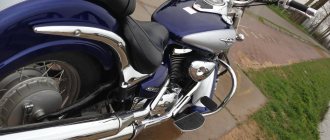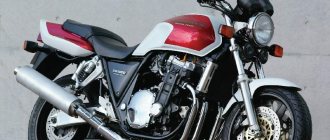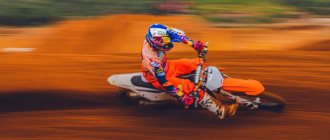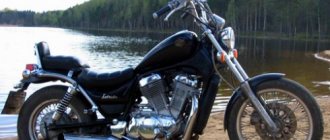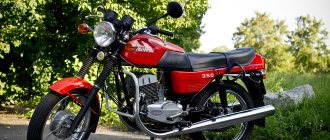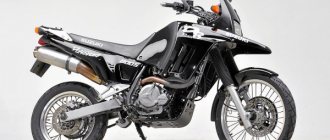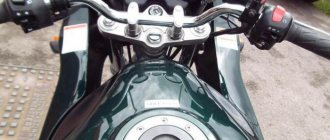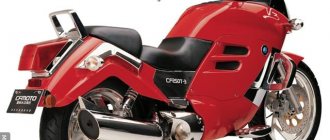It was high time to start keeping a diary of changes and improvements, but there was still too little time... And in the 2015 season, the motorcycle was undeservedly deprived of attention. But now we finally got around to at least starting the essay =)
There will be few photos and their information content is rapidly approaching zero, and the artistic value goes straight to the minus degree. There will also be no artistic format for the entry, rather a simple description in the form of a list.
And so, to the topic.
The 2021 season opened with the most banal scheduled maintenance, namely:
- Changing oil and filters, of which there are 2 pieces. O_o (synthetic Eurol 10W-40). I only changed the oil again in August;
- Soaked the air filter (hellishly sticky blue Bell Ray slurry);
- I tightened the fasteners (Glory to torque wrenches!);
- After a trip to a regional town, about 700 km in both directions, the tires that came with the bike (they were Michelin AC 10) wore down to the state of a slick slick and were replaced. The budget was acutely limited, so I purchased Shinko E700 for the front and E705 for the rear wheel. A short review - the asphalt is excellent (oh, I’ll soon change my opinion about the rubber...) , wear resistance is excellent, rain is terrible... But sand is absolutely contraindicated, well, it’s quite predictable;
- Replaced the front pads (TRW. I have not yet formed an opinion about them due to my little experience);
- Replaced antifreeze (Liqui Moly G12);
- Replaced the spark plug (NGK DPR8EA-9);
- Cleaned the carburetor (the accelerator pump rod was so covered in deposits that it barely moved along the channel);
- I adjusted the dashboard to the changed wheel diameter (the Koso DB-1 dashboard allows you to enter size values);
- Replaced the brake fluid (Liqui Moly DOT 5.1);
- I installed mirrors (I bought them with small endurya ones, through which you can only see your shoulder);
- New grips (the original ones were in rags);
- Installed a new air filter box seal;
- I bought additional passenger footrests with brackets, otherwise my wife was not very happy with the single-seat nature of the equipment)))
- He set the horn (initially, someone tore it out and fucked him). Still, a useful thing in the city.
After the first season on the motorcycle, it became clear what exactly had to be done and what to pay attention to, so the current season began with the December purchase of goodies and consumables.
- Installed a return spring for the rear brake foot. I didn’t feel any difference, but since according to the manual it should be there, let it be;
- I replaced all the plastic fasteners with stainless steel turnkey bolts of 8 (previously there was a wild discrepancy of 4 types of hexagons);
- New battery (Yuasa YTX9-BS). The old one was completely on its last legs, fortunately the bike was produced in those days when enduro bikes were not produced without a kick starter;
- I turned out the bushings for fastening the front wing, now it has stopped turning its nose to the side. Plus I installed a wing booster, which should have been there initially, but was actually missing. The wing stopped fluttering on every pothole;
- I sprayed all the terminals with Mannol contact lubricant, because I don’t care about corroding!
- Soldered the plastic. In particular, the headlight adjustment screw tore the plastic, and the side shield was cracked at the mount. The simple process of soldering brass mesh has been described many times;
- I washed the calipers and lubricated all the guides (I took the lubricant as recommended by VMP Auto MC1600);
- I installed copper washers under the drain bolts, the moto stopped leaking;
- Filters and oil have been purchased and are awaiting replacement (HF 155 and 156 + seals according to regulations). The oil is the same as last year Eurol 10W-40;
- New air filter (the old one came unglued along the seam during washing and was urgently sealed with sealant);
- New brake and clutch levers (the original ones are a little bent, but are quite suitable as spare ones);
- Clutch lever bracket (the original one cracked at the mounting bolt for reasons unknown to science);
- I put on the boot of the throttle mechanism (I think there will be less dirt and the cable will last longer);
- I ordered a new clutch cable (I didn’t need an original replacement, but at that moment there was a discount on a new one);
- Replaced the choke cable (a relative's shirt had broken and was rubbing the cable);
- I ordered a throttle cable. This is where I didn’t sourly go wrong and made a mistake - the working stroke of the new cable turned out to be significantly less than required. Alas, the money was wasted. The reason is that the carb is original to the model, and the throttle handle is from EXC, well, I ordered a cable for the handle, but I didn’t even think of comparing carburetors...
- I bought a steering column lock because... I lost the key from my family. It is inserted into the frame separately; we still have to tinker with pulling out the old one;
- Replaced the stars. Set 15:50 (stock 15:45, but the manual allows for my version). The rear is aluminum, probably the resource will be short, but there are 2 of them, so it will be enough for the season (with the motorcycle we got 14:42);
- Chain DID VX2 X-ring 520;
- Circuit protection. Consists of 2 plastic parts. Fuck knows who and from what it will protect, but at least they stopped throwing grease on the boots;
- Covered the headlight with anti-gravel film;
- I welded the crankcase protection (a small crack spread and the protection began to ring in time with the engine);
- I pasted over the plastic according to my own design (because God himself ordered the designer to customize his mot). But this is a whole topic for a separate post;
- I tightened all the fasteners again with force strictly according to the manual, because torque wrenches must justify their cost =)
- I went through and lubricated the progression, with all the breadth of my soul I filled it with lithium grease with molbdenum.
All this work could have been completed in 3-4 days, but due to the fact that the lazy ass is a terribly busy person, the pleasure lasted for 5 weeks.
Without a throttle cable, I missed the first warm days of the season, and freaked out and got out of the bike ride myself. Oddly enough, the homemade bicycle has already covered nearly 6,000 km and still shows no signs of wear (at the time of writing this article, 07/31/2107). For this, allow me to take my leave.
Bye everyone!
Motorcycle KTM 400 LC4 EGS 1994 review
Description of the KTM 400 LC4 EGS 1994 motorcycle is in the queue for publication of the article. Announcement: Today, for almost every new motorcycle that comes into being, marketers strive to carve out their own niche. This one is a road sport, this one is a recreational enduro. But what class should we include a motorcycle that has a little bit of everything? A good bike should have a reliable engine, comfortable ergonomics and simple controls...
KTM 400 LC4 EGS is a motorcycle not sold in Russia. Despite the fact that good models of motorcycles have a very respectable price, and the season for their use is relatively short, the motorcycle market is developing rapidly. And if you believe the words of dealers, then some models of recently released motorcycles are selling like hot cakes at the beginning of the season, and the models brought to Russia are clearly not enough to fully satisfy consumer demand.
A motorcycle has long ceased to be an alternative to a car, and the times when this equipment was bought only because there was not enough money for a full-fledged car are forgotten. Nowadays, two-wheelers can be called technological marvels in many cases, and their cost can be compared with that of prestigious cars.
Many people have started buying motorcycles for hobby purposes as riding or even collecting them has become a good pastime for many people. Many motorcycles, for example the KTM 400 LC4 EGS, whose technical characteristics make it possible to call the model a prestigious brand, are in demand among both beginners and experienced motorcyclists.
Currently, it is impossible to purchase a new KTM 400 LC4 EGS motorcycle from the 1994 model year, since their production stopped 22 years ago. At the same time, the KTM 400 LC4 EGS has excellent technical characteristics, so many are eager to purchase, if not a new, then at least a used version.
Motorcycles with an engine capacity of 398 cc. see, appeared as a result of long work of inventors who sought to create a model that was not inferior in characteristics to other versions of the motorcycle. In some cases, these models are not only not inferior, but also ahead of other motorcycles, as they have minimal fuel consumption and other excellent parameters.
Motorcycles from 250 to 400 kb. see which includes the KTM 400 LC4 EGS - this is the most common class of motorcycles. In this range you already have a choice among almost all classes of motorcycles. Many people call this category the most suitable for a first motorcycle. You can purchase a moderately heavy, powerful and flexible motorcycle for relatively little money. Many people advise taking a road bike with a 400 cc engine as your first choice. We cannot completely agree with this, because such motorcycles often weigh about 200 kg and have a sufficient power reserve. If your skills in riding a two-wheeled vehicle are limited to a training motorcycle at a motorcycle school, then you should not immediately take such a device. Many beginners get into ridiculous accidents simply because they do not know all the features of operating such equipment. After all, the heavier and more powerful the motorcycle, the better you should know how to handle it in different situations. Even a monkey can just drive in a straight line (no joke).
Go to the entire range of KTM motorcycles, on this page you can find KTM 400 LC4 EGS motorcycles from other years of production and information about them
Test drive KTM200 Duke
The KTM company once again went beyond the ordinary and did everything to break the captivity of the prejudices of its customers. If anyone else thinks that a small capacity bike is not capable of “making your day”, then the KTM Duke 200 will readily prove the opposite!
Last year at the Milan Motor Show I walked around the handsome Duke 125 for a long time and couldn’t believe my eyes. A compact street, made at the highest engineering level, and even with the price of a budget Japanese “250 used” - isn’t this the dream of many motorcyclists? Even then it was clear that the chassis of the motorcycle was designed for a more powerful power unit... And KTM did not take long to beg, presenting a version with a 200 cc engine!
Saturday, a bright sunny morning - one of those that is most pleasant to start with a cup of aromatic coffee. Nothing disturbed the sleepy flow of life on Kontraktova Square until the bass roar of a single-pot Duke 200 engine came from the next street. Even with a stock muffler, this baby sounds very pleasant, and its perky appearance will instantly raise the mood of even the most notorious bore.
Externally, the new Duke is almost the twin brother of its namesake with a 690 cc engine, only smaller. The orange color, bright stickers, and the stylish “plow” in front of the engine suit him extremely well. Look at the embossed tank with pronounced stampings under the knees, the openwork steel frame, the cast swingarm, and the impressive WP fork. The multifunctional instrument panel deserves special mention, which displays not only the usual speedometer and tachometer, but also the total and daily mileage, mileage before maintenance, time and remaining fuel in the tank... How could we have previously imagined an entry-level motorcycle in such a configuration for just € 4200?! This became possible thanks to cooperation with Bajaj, and KTM does not hide its cooperation with the Indian giant. Considering the quality of the Duke 200... What a quality! The love with which the motorcycle was designed is not surprising.
Sitting behind the wheel of the younger "Duke" is surprisingly pleasant. The bike is very compact and the short seat cushion with pronounced lumbar support gives the impression that you are sitting not “on”, but “in” the motorcycle. The wide and high steering wheel creates an upright seating position, but thanks to the high-mounted and rear-set footpegs, there is no smell of “classic” relaxation here. The remote controls on both handles are made of simple plastic, as are the brake and clutch levers - of ordinary metal. Although we remember that this is still an entry-level motorcycle... But all this tinsel fades into the tenth plan as soon as the single-cylinder engine awakens to life!
From a design point of view, this engine is excellent. The basis was the power unit of the 125 cc version with electronic fuel injection and liquid cooling, but its volume was increased by 60%. This change entailed the need to install larger diameter valves (of which there are four), a pair of new camshafts and an enlarged piston. Of course, the intake system has also undergone changes along with the three-component exhaust system, so now the engine produces 26 hp, which is quite enough for a bike weighing 125 kg.
As I already said, it sounds great, and also practically does not vibrate. The first one engages with a satisfying click, and the ease with which the clutch operates is puzzling at first, because the moment the discs close is more like a breeze. The engine spins with obvious pleasure, providing the motorcycle with decent dynamics, and the clearly operating 6-speed gearbox only encourages you to run up and down the gears. The engine is very elastic, and from time to time you simply forget about what gear you are driving in. In this situation, the gear indicator on the dashboard will be an excellent help, which will help you return to reality.
Oddly enough, the power unit is just the tip of the iceberg, because the element of this motorcycle is cornering. A rigid steel frame, a 43 mm inverted telescopic fork from WP, an excellent swingarm, which is said to be created using the same technology as a similar unit on the Duke 690 - this whole bouquet, coupled with an extremely compact and nimble chassis (wheelbase - only -1361 mm) makes it possible to get true driving pleasure, be it active drive in traffic or slalom at low speeds.
The motorcycle is very responsive and easily dives into turns, while on the arc it stands with locomotive stubbornness. Perhaps this is the best chassis in the category of budget motorcycles, as they say, “don’t go to grandma’s door”, and besides, it can easily digest a larger engine, for example, the 350, which is now installed on the new enduro - Freeride! I would also like to say thank you to the designers of the suspensions for increasing their travel to 150 mm, thanks to which the passage of rails, different-sized “policemen”, and just driving on paving stones will not create any problems for the pilot.
The braking system also works in unison with the chassis. The main work falls on the front mechanism with a disc with a diameter of 300 mm and a 4-piston caliper. It works excellently, there is enough performance in any conditions, and on well-warmed tires the motorcycle is not averse to lifting its “tail” under heavy braking. The rear also features a 230mm disc with single-piston caliper. It is blocked quite easily, but this moment is perfectly felt.
The KTM Duke 200 met all my expectations, and even exceeded them in some ways. It pleasantly surprises with its characteristics, workmanship and price, but this is nothing compared to the emotions that the Duke gives while driving. And if one of your friends is thinking of joining the two-wheeled fraternity, recommend the Duke 200 to him. It will not only make your mood orange, but will also bring true pleasure from riding a bike equipped to the highest class. And it’s time for Japanese engineers to learn from the Duke example how to make lightweight motorcycles inexpensively and to the highest standard!
Owner's opinion Victoria Bondar
I myself was very surprised when I decided to buy myself a Duke 200. My first bike was a Honda AX-1, which taught me to love enduro riding through fields, rivers, sand and mud. But then I, like many, came to the conclusion that there should be several motorcycles, and Honda remained for off-road rides, and for trips around the city, last year I began to look for something beautiful and not very aggressive. At the same time, my boyfriend bought a KTM 990 SM, on which we traveled all over Ukraine and Moldova. Since then, I fell in love with the color orange and the “Ready to Race” brand philosophy. The choice was only between KTM Street and KTM Enduro. I decided to stop at the first one and buy a new enduro next year. Before I bought it, I hadn’t even sat on it, and I was very worried how we would become friends. But as soon as I sat on it and rode, we became inseparable. This is the perfect bike for a girl - beautiful, lightweight, with all possible sensors and reminders. The main thing is that at a traffic light I can touch the asphalt with my feet! And fuel consumption is also good - 3.7 liters! But I especially liked the full-fledged gasoline sensor, the calculation of time until maintenance, and the backlighting of all buttons in the dark. By the way, the headlight in the evening is just a fairy tale, all the signs and holes are visible! At the same time, despite its small size and only 200 cubes, it turned out to be very playful, which pleasantly surprised me. I just finished running it in and haven’t yet accelerated it properly, but at 100 km/h it doesn’t just go calmly, it almost says to me: “Vika, why is it so slow, let’s go faster!” However, I don’t know how KTM does it, but the bike really communicates with you, and not only do you adapt to it, but it also adapts to you. Also, while I was driving a Honda, they didn’t pay much attention to it, because it was old and not very expressive in appearance, but now I still can’t get used to the fact that people are constantly paying attention to us now. In general, now I understand that any motorcycle can be, but only if it is a KTM.
Text: Denis Los
Photo: Andrey Shlenchak
